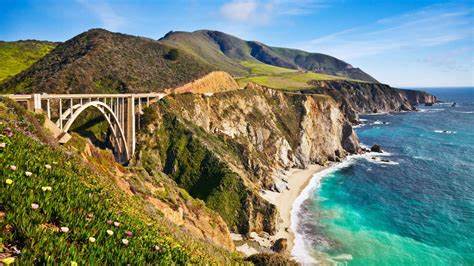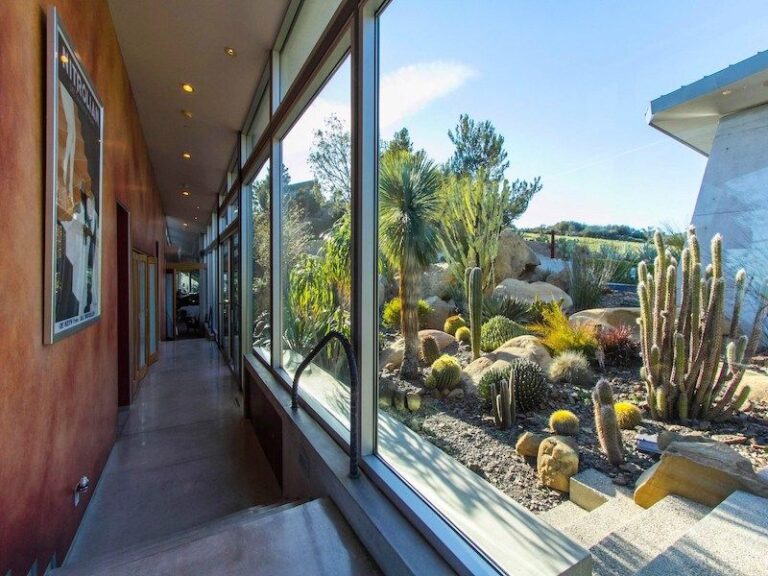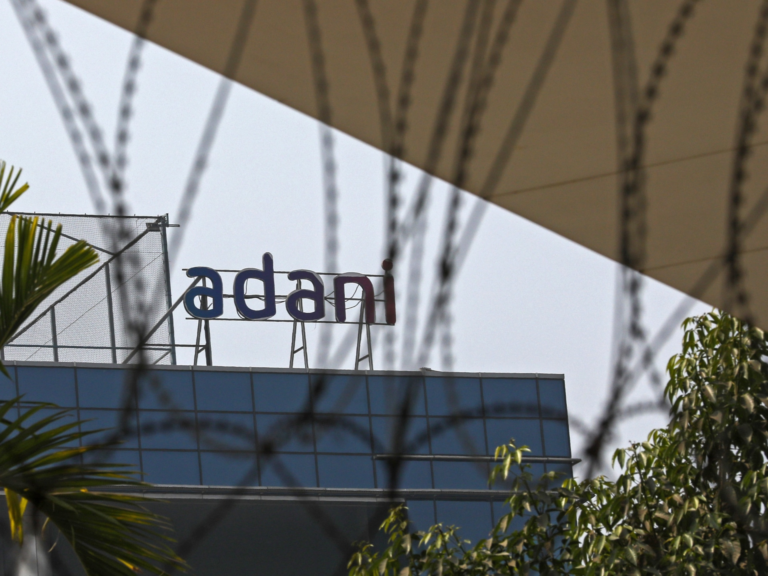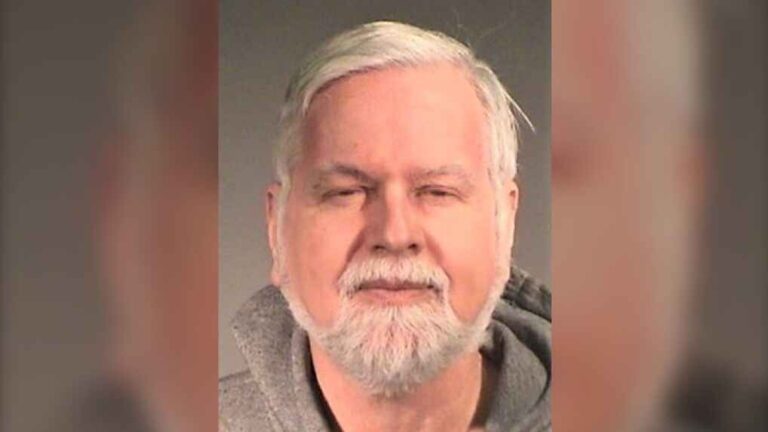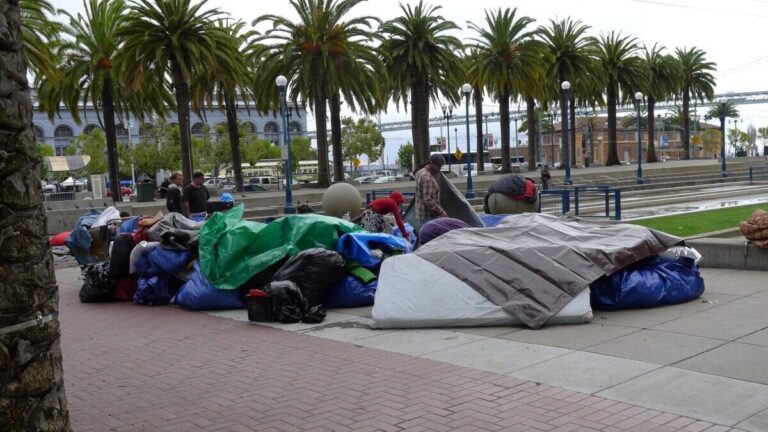Residents in this San Joaquin Valley town, like Maria Arevalo, look at an empty church property the same way they look at the reliability of water in their homes — and say they feel behind on two fronts.The empty piece of land, which holds only three boarded-up trailers and some scattered wooden crosses, sits north of the town of just over 4,000. It is where Arevalo says she believes she had a spiritual moment.
The town of Pixley doesn’t have a Catholic church. And while Arevalo doesn’t recall there ever being one, she began an effort to establish one nearly 20 years ago mostly out of a need to serve her faith, she said. One day, as she worked to clear weeds off a field north of the town, a bird’s hum made her stop and look up. She saw no bird, but it was a lovely sound that nearly brought her to tears, she said. That’s when she thought, “This land is blessed by God. It’s holy.”
Today the land is fenced off and only used occasionally, but no official church exists yet.
A sign at the gate from the Roman Catholic Diocese of Fresno states the church will be built with the help of residents, but a spokesman for the Diocese says there are no building plans currently in the works. Residents will have to keep waiting. Residents have suspected water — or rather the lack thereof — is getting in the way of anything being built there. Water pipes don’t reach the land, residents have asked neighbors to extend lines to no avail, they said, and searching for water underground is something residents can’t afford to do on their own. They already collect money through sales of tamales and raffles to pay for church programs at their nearest church up the highway, Arevalo said.
For some in Pixley, the needs for a place to worship and for reliable water are both affecting everyday life, and they hold nearly equal value among some. If the community had enough of both, it could resolve many of its problems, Arevalo said, adding that a church could act as some form of a higher authority that could watch over the town as youth become prey to gangs or the streets. A steady flow of clean water could restore confidence among families after years of contamination and water shortages. For residents, their fights are related.
The town is surrounded by dairies and farms and contends with high pollution during harvest seasons. It is divided by the busy State Highway 99, which flows big rigs, RVs and cars up and down the Valley. On a recent October afternoon, a column of dust whirled over a bare dirt lot in downtown.
California is in a prolonged drought, which only adds to Pixley’s problems. The community is one of nearly 400 in California whose water systems rated as “failing”. State emergency grants and water-focused legislation offer solutions, but communities face a long road ahead as California enters a fourth year of drought and running water becomes harder to guarantee in some places.
“To live we need the breath of God’s air, God’s spirit, and to live in this world, we have to have water,” Arevalo said in Spanish.

Maria Arevalo, in blue, speaks during a meeting with women from the community of Pixley. The residents routinely meet to discuss issues in their community. Photo by Cresencio Rodriguez-Delgado/PBS NewsHour
Community water challenges
In 2012, California became the first state in the country to define water access as a human right. But a decade later, communities up and down the state still struggle to ensure residents don’t go without it.
The lack of access to safe drinking water is worst in low-income communities made up of mostly Latino and Black residents. A report by the California State Auditor earlier this summer said that the water systems rated as failing serve nearly one million Californians. A majority of those residents live in the San Joaquin Valley.
According to the audit, more than 150 of the struggling systems have been having trouble delivering clean and reliable water for the last five years, and auditors accused the state of not acting fast enough to address drinking water problems.
But officials with the State Water Resources Control Board, which oversees the state’s water quality, said that increased funding over the years to help struggling communities has also meant an increase in communities that are able to apply for water project funds. More available funding from state laws and state and federal grants aimed at drought relief, for example, means more opportunities for communities to apply for it, but the state audit pointed to delays in reviewing applications and issuing funds as a reason why communities are left behind.
WATCH: Jackson water crisis exposes consequences of aging infrastructure
The report said, “the average length of time for water systems to complete their applications and receive funding nearly doubled, from 17 months to 33 months.” Laurel Firestone, a member of the State Water Resources Control Board,said the number of communities seeking assistance with water projects grew “six times just since seven years ago.”
Many communities have historically gone without the investments that could have maintained their water systems, said Firestone. She said drought and long-term aridification in the West is a big factor in the challenges the state is facing around water, but rural communities, which are often unincorporated, have been neglected heavily in the past, and are trying to catch up during one of the worst droughts.

Nearly 400 community water systems up and down California are considered to be failing on things like water quality and accessibility. Contaminants have gotten into the water, and aged infrastructure has proven challenging to fix, leaving communities to struggle for reliable water. Photo by Cresencio Rodriguez-Delgado/PBS NewsHour
Firestone said one of her agency’s main goals is to promote “consolidation” of water systems, a process where a struggling system is connected to a more reliable one to better provide water to residents. The agency has already helped around 80 systems connect, and says about 200 similar projects are underway.
Firestone said funding from state laws such as Senate Bill 200 signed in 2019 by Gov. Gavin Newsom, which established funds to help supply safe drinking water through near- and long-term projects, has slowly begun to reduce the number of residents served by a failing water system. She said help is needed at every level.
“The issue of ensuring people have access to safe drinking water is not an engineering or technical issue. It’s really a human issue. It’s [those] political, social and economic challenges that have created the system we have now,” Firestone said. “There’s many compounding factors, but there’s no question that the race of a community is a major predictor of whether they have access to safe drinking water reliability.”
Communities hit differently, but some keep the faith
Amid California’s drought, some communities have become accustomed to not having enough water, while others are experiencing more stringent effects more directly for the first time. This fall, the community of Coalinga, just over an hour west of Pixley in neighboring Fresno County, was on the verge of running out of its allotted water for 2022. The community is one of several in the San Joaquin Valley that rely solely on water allocated through the U.S. Bureau of Reclamation, which is delivered through the Central Valley Project canals.
Coalinga Councilmember Adam Adkisson said the town had never experienced such a shortfall before, but it’s a sign of the growing issues around water access. In March, the bureau announced it was only allocating its municipal and industrial water customers 25 percent of their usual water due to the drought’s severity. Aside from the Central Valley Project, the State Water Project also makes deliveries to separate water agencies, and also saw its allocations slashed this year. Both canals provide crucial water from upstream reservoirs that have taken a hit from drought.
The city late last month agreed to buy what amounts to roughly 195 million gallons of water from the nearby Patterson Irrigation District for just over $1 million, which will get the city by until the bureau releases its 2023 allocations in March. The funds being used to buy the extra water came out of the city’s own reserve, Adkisson said, but the California Department of Water Resources reimbursed the city for the cost. He said he’s pushing state legislators to think of ways to avoid water shortages as drought intensifies.
The city implemented measures to reduce the use of water, which has had unintended consequences. Residents who’ve paid for landscaping are now seeing browner yards, Adkisson said, and the landscapers who typically worked those jobs are seeing fewer jobs.
“The citizens of Coalinga are obviously getting a lesson in water and where we get it and everything else,” Adkisson said. “There are people who are definitely voicing concerns over the future of Coalinga and they’re definitely contemplating moving out of Coalinga.”

Boarded up trailers and crosses are planted in a dry, open field where a church is expected to be built in the community of Pixley, California. Photo by Cresencio Rodriguez-Delgado/PBS NewsHour
In communities elsewhere in the Valley, there simply aren’t the funds to avoid catastrophe. During the summer, the community of Tooleville had well failure. North of there, the community of East Orosi also saw a well fail due to a power surge that hit the well system. The towns went days without running water in very hot weather. Both towns are majority Latino, and also experience high poverty and rely on state help.
Michael Taylor, an engineer with the firm Provost and Pritchard, who is currently working on water projects in Pixley, said small communities like Pixley often operate on an emergency basis because there isn’t enough funding to fix issues right away. He said in small, and older, water systems, any little issue can cause big problems.
“Emergencies kind of offer a sense of urgency, but if there’s no money to take care of it, then it doesn’t happen as quickly as any of us would like,” Taylor said.
Pixley’s water system has faced contamination from arsenic – a common compound that seeps into the groundwater from soil – on and off for years, and water treatments have attempted to lower the arsenic levels below legal standards. But it is continuing to experience contamination from the chemical known as 1,2,3-Trichloropropane, a manmade chemical found at industrial or hazardous waste sites that is known to cause cancer if consumed over time. The drought has also caused land to sink, due to too much groundwater being sucked out across the Valley, and in Pixley at least one well failed recently after the pipes caved in. Taylor said Pixley’s four water wells don’t produce a lot of water as it is, so when one is out, it spells trouble.
Taylor’s firm is working on multiple projects costing in the millions, which include extending underground water pipes to improve water pressure for homes, and installing a water-filling station that will be free to residents.
READ MORE: Mississippi governor, who opposed water system repairs, blames Jackson for crisis
The free filling stations may offer a solution to residents who don’t have a car or often don’t have spare money to stock up on bottled water, and those are short-term prospects that residents like Arevalo are holding on to. Arevalo has lived in the community since the 1970s, and said she has stayed because it’s been a quiet place to live and she has formed friendships. She said when she first moved there, the water was cleaner than most places she’d lived and when some of it got in her mouth during a shower, it even tasted sweet.
But water quality has fallen, as has the air, Arevalo said. For her, those are things she hopes to see fixed in Pixley. Back at the church property, she looks on to the brown, dry field where the future of the church is unclear. She still keeps her faith that Pixley can improve.
Families are desperate for a place to worship and will drive miles away to the nearest church, Arevalo said. But the town is part of them, and for some, it’s their mission to wait out the drought just as it has been to wait for a church to be built in their own community — where they can hold mass and worship together.
Aside from water, Arevalo said there’s another precious resource to maintain in her community. “We need to reinforce our faith here,” she said.
Search : pbs.org https://www.pbs.org/newshour/nation/%E2%80%8Bin-california-where-water-is-a-human-right-some-communities-still-go-thirsty

